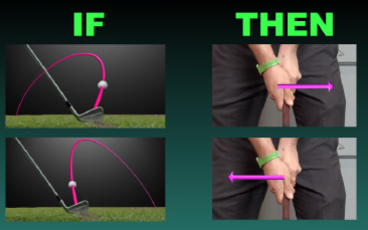One of the first questions I ask a player when working with them is this;
"If the ball does X, what do you do?"
This tells me a lot about their ability to self-coach/fix themselves, and play well when things aren’t going so well.
And, as most of the time it’s not going well for us, golf algorithms seem to be vital if you want to be consistent.
Basic Algorithms
Algorithms are just a set of rules to be followed to solve problems. As an example;
IF shots are going RIGHT, THEN get clubface more left via X
IF shots are going LEFT, THEN get clubface more right (less left via Y)
This algorithm allows a player to look at their directional miss pattern and implement something (a thought/feel/technical change) that fixes it.
We all have algorithms like this already – whether you know it or not. Better players have just learned better algorithms that have a higher percentage chance of working.
Perfection Vs Algorithms
Most golfers believe that learning golf goes something like this
- You pick a swing model to follow (Like Adam Scott’s swing)
- You spend thousands of hours ingraining movement patterns so you swing looks like the model
- When your movement finally looks like the model, you never miss another shot again
Even Scott’s swing misses greens
As a result, most golfers don’t try to learn algorithms to fix mistakes – they hope that learning a model-swing will mean that mistakes never occur – which is a misconception.
If you want to be good at golf – and I mean really good – you need to do both. You need to
- Work towards a better movement pattern
- Build golf algorithms which allow you to fix errors
Advanced Golf Algorithms
A good quality golf algorithm can actually do both – it can be a swing-calibrating and swing-building.
For example, imagine a golfer who slices wildly. They have a weak grip and a left swing path. Their algorithm could look something like this;
- IF shot patterns finish RIGHT, THEN strengthen grip
- IF shot patterns are PULLS, THEN move swing path more RIGHT via X
- IF shot patterns are HOOKS, THEN weaken grip
By using the above algorithm, this player’s shots will become more playable AND their swing will start to neutralize and look more model-like.
I will often give my pupils something like this as it also helps guard against them overdoing a lot of things while we are not together. It serves 3 purposes;
- Evolves the swing towards a better model
- Allows a player to still play well while going through the transition
- Building a player’s toolbox of fixes
Algorithms You Need
Good players have their own algorithms unconsciously internalized. It may be self-represented as a “feel”.
For example, ask any tour player what they would be trying if they were missing right on the course one day and they will say something like “I would be trying to feel X”. On the other hand, many amateurs are completely lost when ball flight errors pop up.
"Anyone can play well when they are playing well, but can you play well when you are playing poorly?"
At first glance, this quote sounds silly – but read it again until you understand what it means. It’s important for you.
as I discussed in my article – The Secret To Perfectly Straight Golf Shots – you might not know when a player is not feeling good about their swing, as they might be fixing issues using algorithms
If you want to be able to play well when you are playing poorly, you will need to have the following;
- An algorithm for when you are hitting heel/toe shots
- An algorithm for when you are hitting fat/thin shots
- An algorithm for when you are missing left/right
So ask yourself, do you have algorithms if the above issues pop up as patterns? How well does your algorithm work on a scale of 1-10?
Building Your Golf Algorithms
How do we build better golf algorithms?
One of the best ways is via skill development drills. These can be drills that allow/encourage you to explore the spectrum of outcomes. For example, even with beginners, I do an exercise where I ask them to;
- Hit 10 shots from the toe of the club
- Hit 10 shots from the heel of the club
- Hit 10 shots in-between (sweet spot)
This starts to build a player’s own internalized algorithms (or feel), as well as increased awareness for what is going on when they hit a shot. In fact, my OWN STUDY showed that this form of practice beat trying to hit the center of the club constantly.
In my study, golfers who tried to hit different segments of the face intentionally learned how to strike the sweet spot more often in post-testing
I outlined an awesome process in Next Level Golf called “feel mapping” which takes these feel-building ideas to another level for face strike, ground contact and directional control.
Technically, helping a player understand how a movement change affects impact, and to what extent, is another way to build algorithms.
In my experience, many amateurs will implement a useless fix (something that doesn’t relate, or is even detrimental to their goals). For example, the other day I had a golfer with a severely in-to-out swing path who was missing left (big hooks). Their algorithm for fixing the hook was to swing more right – which not only made it worse, but created other impact issues (low point control).
This player got an updated golf algorithm.
Many golfers will swing more right (this seems logical) to counter the left shot. However, this can make things worse.
As an instructor, I am at a huge advantage. Not only do I know what happens to a players result if I implement X, but I know to what success-percentage it will work, based on experience from thousands of lessons.






